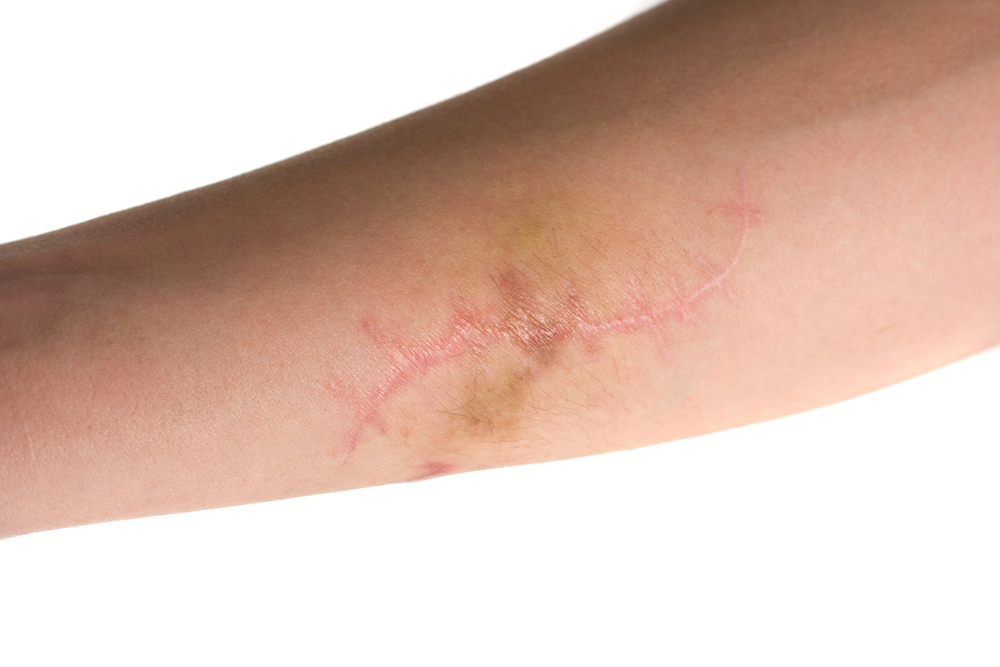Scar revision surgery is used to make scars less conspicuous by making them more consistent with the color and texture of their surrounding skin. A scar is an area of fibrous tissue that forms in place of normal skin after an injury. Almost every wound results in a scar of some degree.
Scars are unavoidable after an injury or surgery, and can be unpredictable in how they develop. Although wounds heal naturally, the scar affects your appearance by leaving behind a raised mark on your skin and discolored texture in that area.
Types of Scars
Keloid Scars: Keloid scars are caused when your body is overly aggressive during the healing process. These scars extend past the area of the original injury. Keloid scars can hamper movement over time. Using pressure treatment or silicone gel pads when you are injured can prevent keloid scar formation.
Contracture Scars: Contracture scars are usually the result of burns. These scars skin make skin tighter, which can impair movement. Contracture scars can extend deep into skin and affect muscles and nerves.
Hypertrophic Scars: Hypertrophic scars are raised red scars, similar to keloid scars. However, they do not extend beyond the area of the original injury.
Acne Scars: Acne scars result from severe acne. Acne scars can vary greatly in appearance. Some are deep pits while others are wavelike in appearance.
Treatment
While scars cannot be completely erased, scar treatment and scar revision can provide more pleasing cosmetic results. Treatment options vary based on the type and degree of scarring. In some cases, simple topical treatments work best. In other cases, minimally invasive procedures produce the best results. In the most severe cases, advanced techniques such as surgical revision require wounds to be closed in order to properly heal.
Treatment options for keloid scars include silicone sheets that flatten scars over time, steroid injections, and even surgery. In the case of smaller keloid scars, it is also possible to use cryotherapy, in which liquid nitrogen is used to freeze the scar. Treatment for hypertrophic scars include silicone sheets and steroid injections, and treatment for acne scars depends on the type and degree of the scars.
Scar removal and revision
It is best to perform scar removal and revision a few months or years after the scar has formed. As scars age, they shrink and becomes less noticeable; therefore, it’s best to not perform surgical revision immediately. It is best to delay the procedure until after the scar lightens in color; this is usually several months or years after the wound has healed. During this time, topical medications and ointments can be used to reduce itching and tenderness.
Scar revision surgery can be done while the patient is awake or sedated, depending on the case. The surgical process includes removing excessive scar tissue. In some cases, a series of small incisions are made on both sides of the scar. This creates V-shaped skin flaps, which results in a less conspicuous scar.
In cases where patients experience the loss of skin protection, treatment requires skin grafting. This involves taking thin layers of skin from a different part of your body and placing it over the injured area. A similar procedure is skin flap surgery, which involves moving an entire thickness (not just layers) of skin, fat, nerves, blood vessels and muscle from a different part of the body to the injured area. Both of these techniques should be considered when a large area of skin that has been lost but the primary concern is function over appearance of the scars.
Looking for a scar revision specialist?
Based in Sherman Oaks, CA and surrounding areas, Dr. Hirsch specializes in reconstructive surgery and scar revision. Schedule a consultation with Dr. Hirsch today by calling (818) 825-8131 and we’ll walk you through the best treatment plan for your situation.

